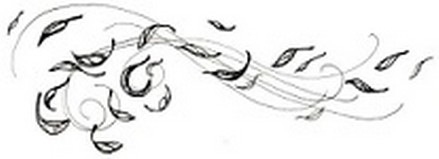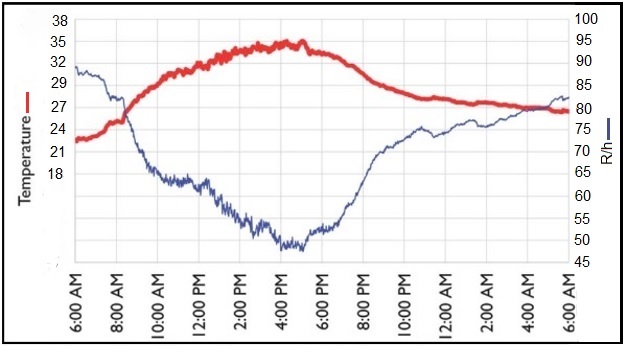How Misting Works
How Misting Works to Keep You Cool
The principles of thermodynamics identify three ways for your body and for the surrounding air to lose heat (cool down):
1. evaporation,
2. conduction and
3. convection.
The air around us and your body can cool off using all three methods and misting will have a direct impact on the air temperature and your comfort on hot days because of thermodynamics.

Misting systems cool the air through evaporation in the same way. As the fine mist is ejected from a nozzle, you will notice it starts disappearing. The hotter it is the faster it disappears. The mist that disappears has evaporated and by doing so, pulls heat from the air around it, leaving the air cooler. The smaller the droplet size, the faster the evaporation occurs. Human hair is about 50μ, millionths of a metre wide. Fine mist that is less than 10μ can take up to 15 minutes to reach ground level from a height of 2.4metres. On a hot day (above 320) it will never reach the ground as it will have already evaporated. Therefore the surrounding area will not get wet. The smaller the droplet size, the greater the surface area for a given amount of water, and therefore, the faster the evaporation. Mistify misting nozzles produce a droplet sizes around 4μ.
Moving Air, Speeds Up Evaporation
If your skin is moist, it feels cool. However, if you stand in front of a fan, it feels cooler. A misting nozzle ejecting mist, that coolness noticeably increases. This is because in motionless air, the water molecules tend to hang around right above the place they evaporated from. This makes the air next to your skin more humid, so there’s less room for any more vapor. Air movement blows away the vaporized water molecules, leaving the air near your skin drier, so there’s more room for new molecules to turn into vapor and float away.
This is a good case for adding Fan Modules into a misting system.
The presence of fine water droplets right on your skin adds two additional cooling mechanisms to the evaporation action and allows misting systems to provide comfort in temperatures over 370. Here’s how:
 • Conduction is the direct temperature transfer that happens when you’re in contact with something (like water) that’s a good conductor. When you use a misting system, each tiny drop of water is cooler than your body temperature, and it will transfer its coolness to the area of your skin that it touches. The water droplets will be cool even on very hot days because they begin to evaporate as they move through the air, and this cools them off before they reach your skin. Water conducts temperature 25 times more effectively than air, so it cools your skin much faster. Here’s an example of water’s excellent conductivity: If you walk outside when it’s 200 the air will feel quite comfortable even though it’s almost 180 lower than your body temperature. You may be fine in short sleeves. However, if you jump into a 200 pool, it will certainly be a cold plunge, and surfers in 200 water often wear wetsuits to keep from getting chilled. You feel colder in the pool than out in the air because the water conducts temperature much better, and it is colder than you.
• Conduction is the direct temperature transfer that happens when you’re in contact with something (like water) that’s a good conductor. When you use a misting system, each tiny drop of water is cooler than your body temperature, and it will transfer its coolness to the area of your skin that it touches. The water droplets will be cool even on very hot days because they begin to evaporate as they move through the air, and this cools them off before they reach your skin. Water conducts temperature 25 times more effectively than air, so it cools your skin much faster. Here’s an example of water’s excellent conductivity: If you walk outside when it’s 200 the air will feel quite comfortable even though it’s almost 180 lower than your body temperature. You may be fine in short sleeves. However, if you jump into a 200 pool, it will certainly be a cold plunge, and surfers in 200 water often wear wetsuits to keep from getting chilled. You feel colder in the pool than out in the air because the water conducts temperature much better, and it is colder than you.  • Convection is the removal of heat from a surface by currents of air or water. When you stand in a breeze, the cool air flowing along your skin carries off some of your body heat. All fans work by convection, and they are helpful as long as the air is cooler than about 370 (your body temperature). If wind (or a fan) blows dry air warmer than 370 onto dry skin, convection will work in the opposite direction and the breeze will actually heat you up. This is why wind in very hot environments adds to the heat hazard. This also explains why 380 is regarded as the danger temperature for any animal with the similar body temperature to humans (horses, dogs and birds for example).
• Convection is the removal of heat from a surface by currents of air or water. When you stand in a breeze, the cool air flowing along your skin carries off some of your body heat. All fans work by convection, and they are helpful as long as the air is cooler than about 370 (your body temperature). If wind (or a fan) blows dry air warmer than 370 onto dry skin, convection will work in the opposite direction and the breeze will actually heat you up. This is why wind in very hot environments adds to the heat hazard. This also explains why 380 is regarded as the danger temperature for any animal with the similar body temperature to humans (horses, dogs and birds for example).Relative Humidity Changes Throughout the Day
If the early morning weather report predicts a hot summer day and the relative humidity is already somewhat high, you may figure that the air will be too moist to use your misting system. However, relative humidity is a way of saying how much of the air’s capacity to hold moisture is already filled up. Warmer air has a larger capacity for holding water vapor, so its relative humidity (or filled-up-ness) is lower. By mid afternoon, when it’s much warmer than it was in the morning, the air has more room for new water vapor and your misting system will be able cool you more efficiently. The following graph explains the situation:

Observed relationship of temperature (left scale) to humidity (right scale)
Some Additional Benefits
Insects deterrent
Ever notice that less mosquitoes and flies are around when there is a breeze. Insects don’t like wind especially if it contains mist.
Dust and Pollution control
Mist is so effective at cleaning smog and contaminants from the air we breathe that China actually deploys “mist cannons” in its most polluted cities as a way of eliminating particulates and smog! You and your employees, friends and family members will all benefit from the improved air quality and cool comfort that a portable misting system offers.
One last thing – The environmental impact of mist cooling
It is estimated by the IEEE (Institute of Electrical and Electronics Engineers) that 95 Litres of water is required for each 1 kilowatt hour of electricity generated. This means to run your air conditioner for 1 hour would indirectly consume between 200 and 230 litres (assuming your air con consumes about 2-2.5 kwh). A twenty nozzle misting system uses a pump about 180 watts and the water it consumes is about 36 litres an hour. A misting system is responsible for consuming about 53 Litres per hour (36 litres of water plus 17 litres indirectly via electricity) versus about 200-230 litres, about a quarter. Mistify's misting systems are about four times as efficient as air conditioning in water usage.


